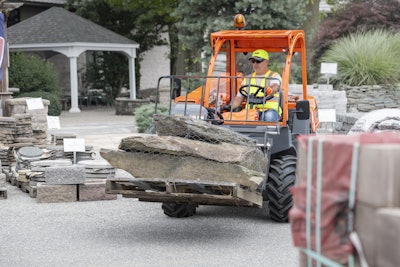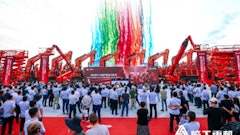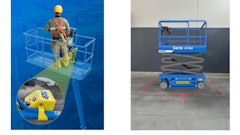
As a concrete contractor, you’re always looking for ways to do your work more efficiently and safely. This is not a one-size-fits-all industry because concrete projects each have unique needs and requirements based on the jobs that must be performed.
Efficiency isn't just a goal for you; it's a necessity in your concrete operations. Optimizing material handling is especially crucial to success when doing concrete work, and the equipment you use is an extension of the specialty tools you need to accomplish the work.
Telehandlers, with their unique capabilities, can revolutionize your concrete operations. Whether you’re moving structural elements, like retaining walls and concrete foundations, to precast concrete slabs and panels, building boards, roof tiles, railroad ties, posts, poles, prestressed bridge beams, and trusses, these tools can be your go-to for lifting and moving heavy concrete loads with precision, ensuring materials are delivered exactly where you need them.
Telehandlers can handle heavy lifting and placing tasks on your concrete projects. They are available in various sizes and configurations, including compact, high-capacity, high-reach, and rotating models. They can pick up and carry heavier loads, up to 27,000 lbs. and more, and pick up and place loads to higher heights, with enhanced reach capabilities, up to almost 100 ft., to provide you with a wide range of options to suit your specific jobsite needs.  JLG Industries
JLG Industries
Trade Tools
Moving equipment and materials on jobsites can be a significant undertaking, especially on large projects. It’s not just about loading and unloading delivery trucks; it’s about helping you get the materials precisely where they need to be. Pallets of material, like brick and block, need to be precisely placed on scaffolding where the work is being done without jostling the temporary structure or damaging the permanent one. Once mortar and grout have been mixed, you need a way to deliver the material to the masonry structure, often at heights that are not reachable without extra lift and reach help.
Traditionally, forklifts or cranes have been used for this type of work, but with all these jobs to be done on concrete jobsites, telehandlers can not only lift higher but also extend further to help you get materials where they are needed. By utilizing a variety of attachments, like pallet forks, brick forks, buckets, and undercarriage hooks, you can gain even more versatility when using these tool carriers on projects.
Precision Placement
Your concrete operations demand precision, and a telehandler can play a crucial role in achieving it. With advanced maneuverability and telescopic capabilities, telehandlers enable you to reach heights and distances that other equipment cannot.
That’s because telehandlers are designed with features that enhance precision. For example, telescoping booms that can rotate attachments allow for accurate positioning of concrete buckets or pumps. This reduces your margin of error and minimizes the need for manual labor, saving you both time and resources.
Rotating telehandlers may also help you create a more efficient work environment by reducing travel on jobs. You can set the outriggers, rotate them to unload a truck, and then rotate them to place the load in a building without moving. Using a traditional fixed-boom telehandler, you would have to pick up the load, back up, and then turn around to face the building before extending the load.
Additionally, compact telehandlers allow you to work in tight spaces and enhance precision through maneuverability, tight turning radiuses, and a smaller footprint.
 JLG Industries
JLG Industries
Enhanced Reach
Working in dynamic environments calls for enhanced reach. Other equipment may struggle to adapt to a project's diverse needs, but telehandlers excel in versatility. Two of the most important aspects of telehandler operation, especially when lifting material into place, you need to understand:
- How much weight needs to be lifted and
- How high the load needs to be lifted.
Telehandlers are generally categorized by maximum lift capacity and/or maximum lift height, and the equipment you’ll be rented or sold is based on these key attributes.
Traditional telehandlers have a maximum reach of 34-56 ft., with high-reach models capable of reaching up to 75 ft. and higher. In addition, rotating telehandlers often allow you to replace a crane and give them the ability to reach up to 97 ft. with a detailed load chart. Placing 4,400 lbs. at 97 ft. can be a game-changer for many jobs. This can benefit you when you need precise concrete placement in challenging locations.
Optimized Handling
You know that efficient material handling is a cornerstone of successful concrete operations. Telehandlers are equipped with robust lifting capabilities that enable the swift and safe movement of materials across your concrete work sites. This accelerates your construction process and minimizes the risk of accidents or damage to your materials.
Some telehandlers are designed for maximum stability and control, allowing you to handle heavy loads confidently. Features like precision control and load management systems contribute to enhanced material handling, ensuring your operations run smoothly and without disruptions.
 JLG Industries
JLG Industries
Added Versatility
Accessories for telehandlers contribute to their productivity and efficiency. Telehandler attachments, for example, offer more flexibility on jobsites, from picking and placing palletized loads to bucket work and suspending loads.
When equipped with different attachments, like concrete buckets, forks, and grapples, a telehandler becomes even more adaptable for completing various concrete-related tasks. For example, the telehandler's ability to extend its reach with a telescopic boom allows you to pour concrete into hard-to-reach areas, whether a high-rise construction project or a confined space. Or, you can install a fork-mounted work platform on a carriage attachment and lift personnel for jobs requiring hands-on work at heights.
You may also find specialty attachments, like sweepers, helpful in tidying up jobsites and surrounding areas by collecting concrete debris into a hopper for disposal. And, fork-mounted trash hoppers allow you to empty the hopper’s contents without leaving the comfort of the telehandler cab. A telehandler equipped with these accessories can be a valuable addition to your equipment fleet, helping to keep your concrete projects clean and safe.
Training Requirements
Job site safety when using telehandlers in concrete work begins with training. It’s more than optimizing productivity and minimizing downtime; it’s also about learning from qualified instructors to help prepare you to make the right decisions at the right time when operating and/or servicing telehandlers.
Understanding the training requirements and individual responsibilities for telehandlers as outlined in the Powered Industrial Truck 1910.178 regulations mandated by OSHA is vital for the safe use of this type of access equipment.
Per OSHA, your telehandler training should consist of a combination of formal instruction (e.g., lecture, discussion, interactive computer learning, video tape, written material), practical training (demonstrations performed by the trainer and practical exercises performed by the trainee), and evaluation of your performance in the workplace. All of your operator training and evaluation should be conducted by persons with the knowledge, training, and experience to train powered industrial truck operators and evaluate their competence. These training regulations encompass all sizes and classifications of telehandlers.  JLG Industries
JLG Industries
Many OEMs offer operator and maintenance training for telehandlers. Following guidance from ANSI (American National Standards Institute) and the Industrial Truck Standards Development Foundation (ITSDF), which have developed safety standards for these machines addressed in B56.6, training opportunities led by these industry experts support safety, confidence, and compliance. By taking advantage of industry training offerings, you can stay compliant and safe when using telehandlers in concrete applications.
Improving Operations
Because telehandlers are versatile and adaptable, you’ll soon discover that these machines will typically be the first on your jobsites and the last to leave. From the initial preconstruction phases of a concrete project, where you can use them to unload trucks and deliver materials, to the closing stages, when you can utilize them for cleanup work, telehandlers will offer you innovative ways to improve efficiencies and safety in your next precast projects.


















